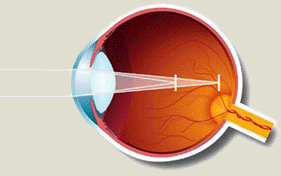Your Changing Eyes |
If you experience a distortion or blurring of images at all distances – nearby as well as far -you may have astigmatism. Even if your vision is fairly sharp, headache, fatigue, squinting and eye discomfort or irritation may indicate a slight degree of astigmatism. A thorough eye examination, including tests of near vision, distant vision and vision clarity, can determine if astigmatism is present.
Astigmatism is not a disease nor does it mean that you have "bad eyes." It simply means that you have a variation or disturbance in the shape of your cornea.
How is it diagnosed?
 Astigmatism is diagnosed in the course of a thorough eye examination. If the degree of astigmatism is slight and no other vision correction such as nearsightedness or farsightedness, are present, corrective lenses may not be needed. If the degree of astigmatism is great enough to cause eyestrain, headache or distortion of vision, prescription lenses will be needed for clear and comfortable vision.
Astigmatism is diagnosed in the course of a thorough eye examination. If the degree of astigmatism is slight and no other vision correction such as nearsightedness or farsightedness, are present, corrective lenses may not be needed. If the degree of astigmatism is great enough to cause eyestrain, headache or distortion of vision, prescription lenses will be needed for clear and comfortable vision.
How is it treated?
Your eye care professional will recommend corrective eyewear, contact lenses or spectacles, to help the eye direct light in a more effective manner. The corrective lenses needed when astigmatism is present are called Toric lenses and have an additional power element called a cylinder. They have greater light-bending power in one axis than in others. Your eye care professional will perform precise tests during your eye examination to determine the ideal lens prescription.
What causes astigmatism?
Astigmatism usually occurs when the front surface of the eye, the cornea, has an irregular curvature. Normally the cornea is smooth and equally curved in all directions and light entering the cornea is focused equally on all planes, or in all directions. In astigmatism, the front surface of the cornea is curved more in one direction than in the other. With the cornea’s shape more like that of an American football or rugby ball than a basketball, the light hitting the more curved surface comes to a focus before that which enters the eye through the less curved surface. Thus, the light is focused clearly along one plane, but is blurred along the other so only part of an image can be in focus at any time. This abnormality may result in vision that is much like looking into a distorted, wavy mirror. The distortion results because of an inability of the eye to focus light rays to a point.
How does astigmatism affect sight?
The crystal clear cornea is situated at the very front surface of the eye and enables light to enter the eyeball. The cornea accomplishes about four-fifths of the refractive work needed for clear vision, bending light rays toward one another into a point. The lens, located behind the cornea, further refines the refractive work begun by the cornea and directs the point of light toward a precise location on the retina, known as the fovea. If light is not focused into a fine point on the fovea, the image that reaches the retina cannot be clearly transmitted to the brain.
When astigmatism is present, the surface of the cornea is distorted instead of being spherical. It is unable to focus light rays entering the eye into the fine point needed for clear vision. At any time, only small proportions of the rays are focused and the remainder is not, so that the image formed is always blurred. Usually, astigmatism causes blurred vision at all distances.
Why are corneas shaped differently?
Not all corneas are perfectly curved, just as sets of teeth are seldom perfectly aligned. The degree of variation determines whether or not you will need corrective eyewear. If the corneal surface has a high degree of variation in its curvature, light refraction may be impaired to the degree that corrective lenses are needed to help focus light rays better.
The exact reason for differences in corneal shape remains unknown, but the tendency to develop astigmatism is inherited. For that reason, some people are more prone to develop astigmatism than others.
Who develops astigmatism?
Astigmatism is very common. Some experts believe that almost everyone has a degree of astigmatism, often from birth, which may remain the same throughout life. Of interest to parents and those who work with children, astigmatism may contribute to poor schoolwork but is often not detected during routine eye screening in schools.
Does astigmatism get worse?
Astigmatism may increase slowly. Regular eye care can help to insure that proper vision is maintained.
How will astigmatism affect my lifestyle?
You may have to adjust to wearing contact lenses or eyeglasses if you do not wear them now. Other than that, astigmatism probably will not significantly affect your lifestyle at all.
